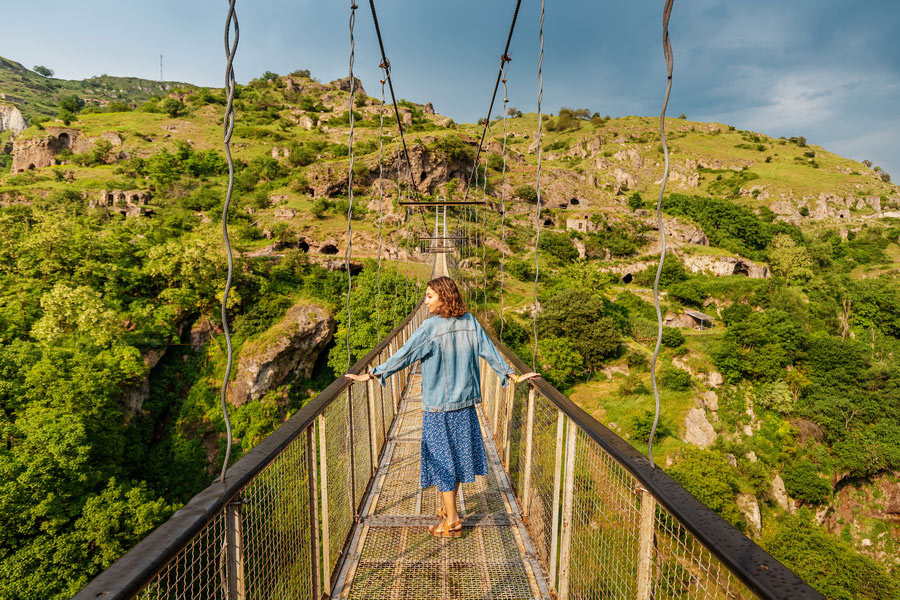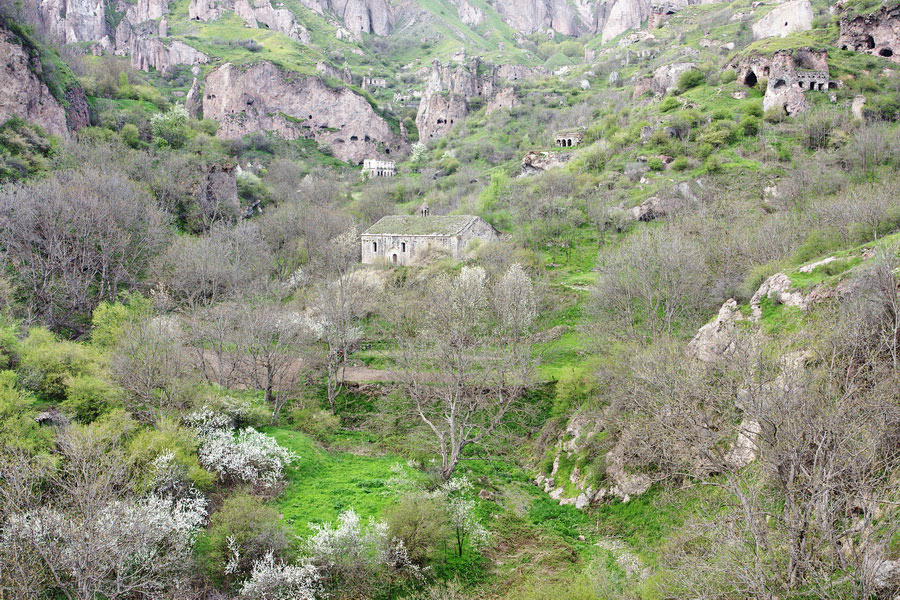
Old Khndzoresk is a historic village located on the steep slopes of a gorge in Syunik Province, Armenia, just 13 kilometers from the city of Goris. "Khndzoresk" translates from Armenian as "Apple", and many speculate that the many apples native to the region occasioned the village name. According to others, the village was once called Khor Dzor (Armenian Խոր Ձոր, Deep Abyss) due to its strange location on the steep slopes of a gorge. Both variants are plausible, for the ravine is indeed deep and the apples are plentiful.
Old Khndzoresk is famous for its canyon with picturesque rock formations and cave settlements which have captured the imagination of numerous Armenian writers and painters. Hikers and and anyone with an appreciation for nature will not want to miss this site!
History
The oldest surviving record of Khndzoresk dates to the 13th century Syunik historian Stepanos Orbelyan, yet we know that people have inhabited the ravine for thousands of years. At one time Khndzoresk was one of the largest villages not only in Syunik Province but in all of eastern Armenia.
18th-century Khndzoresk is known for its role in the liberation movement of David Bek village, and Khndzoresk Fortress served as a military base for national hero Mkhitar Sparapet from 1728-1730. In 1735, the village was visited by the Head of the Armenian Apostolic Church, Abraham Kretatsi, who gave a thorough description of the community in his writings. According to Kretatsi, at that time the Khndzoresk caves were used not only as dwellings but also as shelters. To reach the houses located at a height of 20-30 meters, residents had to clamber up and down with the help of ropes. The houses were arranged so that the roof of one served as a yard for the other and from a distance, the village resembled a large multi-story building.

The village population, which hovered around 4200 people in the 19th century, rose to 8300 by the turn of the 20th century. In 1913 there were 27 shops, 3 paint shops, leather workshops, seven schools and four churches in the village. The people of Khndzoresk engaged in fieldwork, cattle breeding, gardening and handicrafts. Its painters, carpenters, tailors, shoemakers and carpet weavers were skilled craftsmen who often served the neighboring villages too.
In the 1950s, Soviet authorities relocated the residents of Khndzoresk to a more accessible village on the top of the gorge, named New Khndzoresk. The last inhabitant left his cave dwelling in 1958, yet those who were born in Old Khndzoresk are still sentimental toward their village and sometimes return to show the area to visitors.
Legend
According to legend, the founders of the village were two hunter brothers, Janaghan and Tavari. To escape a Persian massacre, they fled and hid in the forest. After peace was established, the brothers went hunting and, chasing a deer, they found themselves at Khndzoresk Gorge. Fascinated by the place, the brothers decided to settle there, and the people of Khndzoresk have skillfully utilized the mountainous terrain for their livelihood and self-defense ever since.
Architecture and Sights
Most of the dwellings were once two-and three-story buildings, and some even had balconies. The perilous layout required some inhabitants to descend the cliffs with ropes in order to reach the entrance to their homes. Certain caves were used as storage rooms instead of homes.
Old Khndzoresk has suffered from multiple invasions and numerous earthquakes over the years. Today, the only remaining structures are Khndzoresk Fortress, Church of St. Hripsime, Church of St. Thaddeus (both 17th century), a bell tower, arches, the ruins of Anapat Church and an old center for writing.
A 160-meter-long swinging bridge, built in 2012, has became another highlight of the village. Khndzoresk Swinging Bridge provides access to New Khndzoresk village and breathtaking views of the caves below. As Khndzoresk Bridge swings 63 meters about the ground, it is not recommended for people who are afraid of heights.
A visit to Old Khndzoresk is highly recommended for tourists to Armenia. A drive from Yerevan to Khndzoresk takes approximately four hours, and although the region generally has mild winters, the best time to visit is from April to November.

